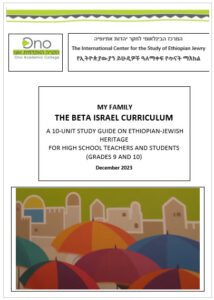MY FAMILY
THE BETA ISRAEL CURRICULUM

THE GREATER JEWISH STORY: AFTERWORD BY DR. CHAIM PERI
FOUNDER OF YEMIN ORDE YOUTH VILLAGE IN ISRAEL
The curriculum enclosed in this book is a pioneering and unprecedented undertaking in the field of Jewish education. Seeking to uncover an enchanting, arcane chapter in the history of our people, it reveals content that is both novel and profound.
The people behind this project had YOU in mind. You – a Jewish educator confronted with the realities of the third decade of this millennium: a world bombarded by external stimuli and distractions, endless facts and figures, superficial knowledge, where anything you want to find out is only a click away.
As educators, we have thus lost our traditional position as primary depositories of knowledge and information. Some may even suggest that we can be replaced by automated processes, by apps or bots. Yet still, as we face our students, children growing up in this chaotic existence, we may ask ourselves: What is the game changer? What is that special something that I can offer these children, that I can personally trigger, so that their inner life is affected? How can I help them develop their core humanity, the Jewish and universal values crucial to their existence as upright and mature members of society?
Society. A word which encompasses and magnifies every change in individual perception and understanding; the collective experience of humanity, which is both astonishingly fluid and obstinately archaic. Perhaps the only thing we can say for sure about society is that it has become increasingly multicultural. We cannot close ourselves in neat cultural bubbles as this is the way the world is changing and changing fast. How can then we offer an adolescent, who is traversing the rough seas of identity formation, a healthy basis for emotional growth, grounded in a solid sense of self?
Our task as educators is to prepare the young generation for a world in which ethnicity and cultural diversity play an increasingly dominant role. And here, Judaism is not as monolithic as it may seem. Just as in previous historic junctures, in which outer circumstances demanded of us to make adaptations in our expressions of spirituality, now is a time to broaden our self-perception as Jews and as human beings – making the leap together with our students. Only then will we be able to maintain Jewish relevance in the context of rapidly evolving social diversity.
The extraordinary story of Jewish continuity in Africa over thousands of years, running parallel to – yet separate from – the rest of the Jewish world, challenges us to open up to a new Jewish angle, and perhaps even retell the Jewish story.
The Ethiopian branch of Judaism has preceded Christianity in this African land; it is a Judaism that has sustained a kingdom; that has fought to preserve its identity, that has survived physical annihilation and spiritual persecution, and every kind of restriction. Yet, against all odds, survivors of these tremendous trials and tribulations now play an active and meaningful role in present-day Israeli society. While in many ways their struggle continues, a fascinating young generation has arisen, and you will find them contributing their unique share in the academia, in the arts, and in all walks of life.
The story of this generation, of twenty-first century Ethiopian Israelis, and of their forefathers and foremothers going back in time, is both enchanting and inspiring.
On the one hand, mythical content describing the ten lost tribes beyond the River of Sambation, zealously adhering to their faith, to their Jewishness; collectively heeding the call to rise to Jerusalem. Propelled by sheer devotion and inner strength, Beta Israel set out on an arduous and perilous journey.
On the other hand, there is the practical setting for the rescue of Ethiopian Jewry. the State of Israel has opened its gates to each one of the diasporas tribes yet has taken much longer to reach out to our kin in Eastern Africa. And not a moment too soon – the rescue operations enacted by the State, urged on by the American Association for Ethiopian Jews (AAEJ) and other devoted protagonists in the US, are themselves a tale to be told.
What makes this story even more captivating is the tenacity of the rescued. While the general populace in Ethiopia adopted the narrative of the biblical Ark of the Covenant lying in Aksum, the Ethiopian Jewish community held firmly to their faith in Jerusalem. With resolute courage and endless sacrifice, they adhered to the vision of glory and redemption in Jerusalem, a dream passed on from generation to generation with the firm conviction that it will come true.
RECONNECTING WITH OUR COLLECTIVE ROOTS
For almost three decades, I had the privilege of heading Yemin Orde Youth Village on Mount Carmel. At Yemin Orde, youth from across the globe converged, effectively forming an ethnically diverse Jewish community, in which issues of identity and cultural affiliation were thoroughly explored.
The first major waves of aliyah from the Ethiopian diaspora that reached Yemin Orde, in the early 1980s and 1990s, made a great impact on village life. We, the veteran Israelis, were humbled and inspired by their ingrained values, human sensitivity, serious demeanor, and exceptional capacity to learn and to give of themselves. No doubt, these qualities were a product of their early conditioning, growing up in the context of an extended family and tribal community. Be it from the far-flung Simien Mountains, or from among the hundreds of villages in the provinces of Tigray, Amhara, or Bahir Dar, what all these wonderful children had in common is that they were brought up according to the ancient rule of thumb: “It takes a whole village to raise a child.”
Even as seasoned educators, our encounter with these youth opened our eyes to essential components in human upbringing. We realized that, especially for vulnerable populations of immigrants, who have had to endure culture shock, we must provide a supportive educational environment which somehow replicates the village way of life. Over the years, this became a structured educational methodology, titled “The Village Way.”
In this era of the so-called global village, we are witnessing social fragmentation and alienation, along with the rise of technologies so advanced that they redefine the boundaries of what it is to be human. Children especially are unceasingly exposed to flashing screens, to an alluring influx of “content” – almost left to fend for themselves against this bombardment of stimuli. How does this affect the human psyche, we can only guess – we are all taking part in an epic experiment, a work in progress.
The Village Way recognizes that although humanity has progressed technologically, the human being has not fundamentally changed since the days of village life in the most ancient of civilizations. We are intrinsically wired to community life, to unplugged, face-to-face human interaction. We need that to develop important qualities such as empathy; we need it for our emotional wellbeing and sense of belonging.
ON CULTURE AND IDENTITY
Indeed, our African teens have shown us what we as humans need in order to become functioning and contributing members of society. Along with that, our concepts of Jewish observance and faith were expanded thanks to our exposure to Beta Israel. Over the years, Yemin Orde has hosted many groups of American adolescents, Jewish groups such as Boston-based “Teens for Tzedek” program, the Elijah Cummings Programs for African American youth of the Baltimore area, and others. Every summer we would marvel at the depth of these young Americans’ personal transformation after being exposed to the Ethiopian Jewish fascinating, Biblical heritage.
This led me to believe a similar kind of learning experience could and should be replicated in Jewish educational settings throughout America. Such an exposure could serve to expand the boundaries of the students’ self-perception, learning to include their African-Jewish sisters and brothers in their inner world. I have personally found such educational experiences to have far-reaching positive impact on the formation of emerging young personalities. I strongly believe that recognizing the Ethiopian-Jewish heritage as a legitimate, if not inseparable, part of the curriculum in Jewish schools will contribute to the students’ emotional growth as well as to their intellectual flexibility.
Within the premises of such a program, educators could include exciting sessions of intellectual discovery E.g., children could look for the 20 lost books that were passed by the Ethiopian Jewish community from generation to generation; or they could virtually join the early Jewish explorers – Eshkoli, Warmbrand and Feitlovitz – in their perilous quest to reach our Ethiopian brethren. In the process, they will find out why these explorers considered Ethiopians to be an ancient Jewish community that preserved pre-Pharisee traditions. They will be able to take a fresh new look at their own tradition by learning about the ancient heritage of Ethiopian Jewry, who strictly adhered to the original rule of law for millennia, preserving traditions with which historical, rabbinical literature is unfamiliar.
A JEWISH-ETHIOPIAN DENOMINATION
The halakhic tradition of the Beta Israel is, undoubtedly, one of the most overlooked aspects of this community. All customs and religious codes, stemming from Biblical times, were passed on by oral tradition from generation to generation, while rabbinical literature was unfamiliar to them.
The bible in their possession was translated from the Greek Septuagint to Ghez, the holy language of the Ethiopian Church, yet nineteenth century missionaries in Ethiopia, such as Plad, Stern, and D’Abadi, viewed the Beta Israel community as fully-fledged Jews and, as such, a target for conversion. The first Jewish explorers of this community, in the nineteenth and twentieth century, considered them an ancient Jewish sect that maintained and preserved pre-Pharisee traditions.
Tracing the Beta Israel to pre-halakhic Judaism is based, amongst others, on the community’s strict observance of religious laws, such as those referring to spiritual, physical cleanliness – “tahara”. The impurity caused by contact with the dead was dealt with by using the ashes of the red heifer without blemish.
Some of the Beta Israel practices are in contradiction to the Pharisee codes: For example, the community did not accept the principle that life preservation overrides the observance of the Sabbath, and marital relations were prohibited on this holy day. It was also strictly forbidden to keep a previously lit fire burning.
Another fascinating feature of Ethiopian Jewry’s unique tradition is the Beta Israel calendar. Similar to the Qumran calendar, they ensured that holidays would not fall on a Sabbath. The members of this community used a lunar calendar of twelve months, each comprising thirty days. In order to overcome the disparities between the solar and the lunar calendars, they added an additional thirteenth “month” of five days every year. There is much yet to be researched and discovered about this time- keeping traditions, which in any case, is in absolute discord with Ethiopian Christian traditions and alludes to their ancient Jewish origins.
Finally, there is the richness of Jewish folklore, music, dances, and food in Ethiopia; stories of courage and sacrifice in the community’s legendary quest for Zion; the prominent place of Beta Israel women against the backdrop of Africa’s patriarchal society; and above all, deep spirituality. All these can be passed on to the young generation of Jewish Americans, who deserve to be deeply connected with one of the most captivating phenomena of contemporary Jewish life.
Of course, there are also difficult points to contend with, for example, the challenges and mistakes made in the integration of the community into modern Israel. This can be an opening point for debate about acceptance of the other, and for discussions about the differences between the various traditions. In this way, the genuine significance of the Ethiopian Jewish heritage is highlighted, and although some aspects of it do not correspond to rabbinical literature, it is shown to hold its own special place in Jewish history in a manner that is in no way inferior or deficient.
THE HUMANIZING FACTOR
One of the greatest Israeli educators of our time was Professor Reuven Feuerstein z”l, a recipient of the prestigious Israel Prize who was internationally renowned for his pioneering contribution to the field of education. Prof. Feuerstein taught us the crucial importance of the human factor in education, and especially, that the educator should be aware of his or her role as human mediator. Each and every interaction with a student, he posited, is an act of mediation between the child and the world. Beyond the specific piece of knowledge that is being transferred, it is the quality of the mediation which plays a major role in influencing the child’s inner world.
This, he called the Humanizing Factor.
Thus, in the mediation process, the facts and ideas which are being imparted are always endowed with a weight of meaning. In this regard, Prof. Feuerstein places great emphasis on the presence of intentionality – the educator’s active participation on the level of intention.
The authors of this curriculum had two options before them: either to tell the story, or to empower the storyteller. It would be tempting to take the first route, elaborating on the fascinating history of Beta Israel. One could compare the various academic theses on their origins, sail away to the distant days of Ethiopia’s Jewish kingdom or give an account of the persecution of Ethiopian Jews and the annihilation of entire communities. Of course, there would also be a description of the long separation from the rest of the Jewish diaspora, the twist in the plot with the reconnection during the nineteenth century, on to the ensuing waves of aliyah.
However, in this digital age, anyone with interest and motivation can simply look up the two words “Ethiopian Jews,” and a wide array of resources will manifest. Still, the Humanizing Factor remains irreplaceable. This program leaves the door open for educators to discover for themselves the existential opportunity that lies in this unique Jewish story, while providing a basic structure which is easy to follow and use, and which can support one’s personal creativity in mediating this captivating tale.
While it may take time before such a program is accepted as part of the formal study curricula of schools and communities across the United States, My Family – The Beta Israel Curriculum is now available just for you, carving the path for this important educational journey by offering a structured pedagogic framework.
The curriculum to which you are exposed in this book is a pioneering and unprecedented enterprise in the field of Jewish education whose purpose is to reveal a magical and vague chapter in the history of our people, as well as both innovative and profound content.
The people behind this project thought of you. You, a Jewish educator coping with the realities of the third decade of this millennium: a world bombarded with external stimuli and distractions, endless facts and data, superficial knowledge, where everything you want to discover is just one click away.
As educators, we have thus lost our traditional position as primary repositories of knowledge and information. Some may even suggest that we can be replaced by automated processes, apps, or bots. And yet, as we deal with our students, children growing up in this chaotic existence, we may ask ourselves: What does the game matter? What is this special thing that I can offer to these children, that I can personally activate so that their inner life will be affected? How can I help them develop their human core, the Jewish and universal values essential to their existence as upright and mature members of society?
Our mission as educators is to prepare the younger generation for a world where ethnicity and cultural diversity play an increasingly dominant role. And here, Judaism is not as monolithic as it may seem. Just as in previous historical intersections, where external circumstances required us to adjust our spiritual expressions, now is the time to expand our self-perception as Jews and as human beings – to make the leap together with our students. Only in this way can we maintain Jewish relevance in the context of rapidly evolving social diversity.
In this sense, this program is one of the greatest gifts given to us by our Ethiopian brethren, because studying their chronicles and cultural heritage enables us to embark on a journey of self-discovery.
For our students, living in a culturally and ethnically diverse society, their story opens a golden gate to new horizons of thinking. This book salutes an age-old expression of Judaism that remains intimately connected to the original – from dawn to dusk, from Shabbat to Shabbat, from generation to generation, from the biblical period to the present day.
Through the program, we invite you, educators, to embark with your students on a journey from the particular to the universal. The particular – to be exposed to and get to know the special and unique story of Ethiopian Jews from then until today, a story that is unlike any other historical story of the various tribes of Israel.
On the other hand, it gives us the opportunity to discover what is shared and universal to this story and to the story of each and every one of us as similar and different. The journey to self-discovery through the different and the other.
CHAIM PERI
FOUNDER OF YEMIN ORDE YOUTH VILLAGE IN ISRAEL & FOUNDER-DIRECTOR OF YEMIN ORDE EDUCATIONAL INITIATIVES, A MODEL FOR TRANSFORMING THE LIVES OF AT-RISK CHILDREN







